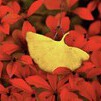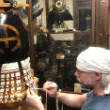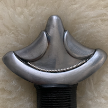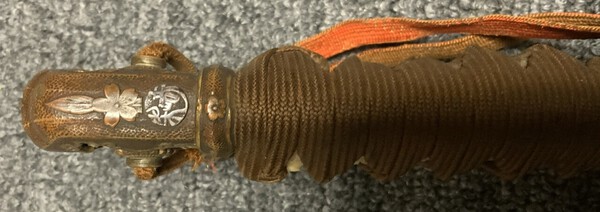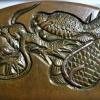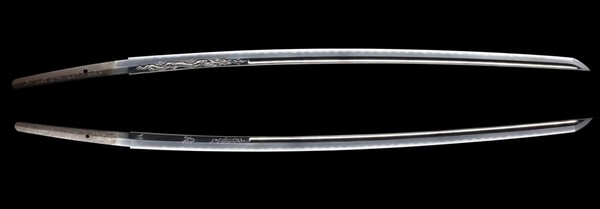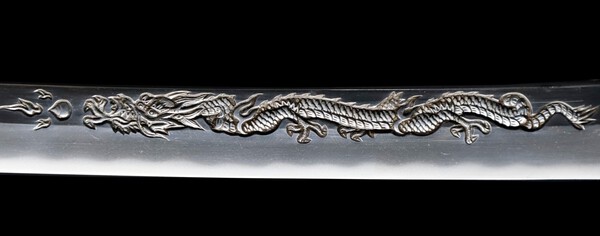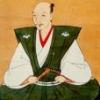Leaderboard
Popular Content
Showing content with the highest reputation on 07/23/2024 in all areas
-
Your paper is not NBTHK’s paper, though it imitates the style of NBTHK. It was issued by 美術日本刀保存審査會 (Bijutsu Nihonto Hozon Shinsakai) in 1974.3 points
-
Also adding this just as a reminder, but when corrected and pressed on the matter, Dave's only answer is avoiding it altogether with the millenia old "I don't have time for this" excuse despite having time to slander well respected people like Nishioka, then making an insultingly unrelated explanation about a long dead historical figure that looks like it was written by chatgpt on a bad day, moving the goalpost with semantics about urushi terms, then bringing up his online nemesis, saying that he shouldn't boast about his skills while he himself boasts about them one line further. Again, were this dispute about Nihonto, this matter would already be dealt with.3 points
-
There's not a lot of people interested enough in armors, not as much as people interested in Nihonto. This means that if someone with a semblance of authority starts poisoning the well, it destroys it for everyone. From what I've learned by going really in depth and meeting with artisans and reading books, visiting castles and museum, I can agree with Andy that Dave is basically talking out of his ass, willingly or not. If Dave was presenting himself as a koshirae maker spewing nonsense and trying to make it pass as truth on this forum, he'd likely be kicked out, and everyone would call him out. I'm mostly interested in armor stuff and I don't want to see people spinning lies about the topic, sharing disinformation was never the point of this forum I wager but here we are. It's not about Dave vs Andy, any goddamn Katchushi I managed to meet, or whose work I've seen has had interesting information to share that directly contradicts the claims that Dave made about armor. So either most Katchushi in Japan, as well as museum backed books are totally wrong about their field but for some reason Dave, unable to use proper Japanese, isn't for some reason, or maybe he's just lying. If you just lock this thread it's going to start over again in a month anyways. Just to say, if it was the same thing about swords, that matter would be dealt with more swiftly. Except one side is obviously spewing nonsense, anybody who has read even a few books on the topic, or that even know toddler level of Japanese can notice that maybe Dave doesn't really know what he's speaking about?3 points
-
2 points
-
2 points
-
2 points
-
Hello from the UK, hope you are all well all around the planet. The help and advice that you kindly gave Howard has prompted me to get the camera out and likewise seek your assistance. I know virtually nothing about Kabuto so please excuse my use of incorrect terminology. I bought this a while ago (together with a menpo) mostly for display because I liked its visual impact. The bowl is iron and it is in fairly rough shape. I have gently wiped and waxed it - hoping I’ve not committed any serious sin! I’d love to get your opinions on age…..and anything else you can tell me. Is the neck guard original to it? I assume it is nothing special as it was relatively inexpensive. Grateful thanks in advance. Best. Colin1 point
-
1 point
-
Sherif, The other is a lightweight parade sword in shin gunto mounts. See the below reference. I also have one that looks very similar to this example. Very cool! @Shamsy@Bruce Pennington Conway https://www.militaria.co.za/nmb/topic/22122-paradelight-weight-gunto/#comment-2250121 point
-
1 point
-
I have a set of fittings by a guy named Ejuken Motohide, (H05858). Haynes Lists him as being a student of Okawa Motoshige (H05920), but i cant find either in Seskos geneaologies list. Is Okawa Motoshige a Oyama/Sekijokoen man? if so would that place this guy as a student of the same school? Also, haynes lists a few resources where his fittins have been published, I was wondering if anyone has access to scans or pictures of these references: Victoria & Albert Museum M1607-1931 Mosle p. 500 #16071 point
-
Yes, the paperwork is correct. Nice. Jan Pettersson has an almost identical one from Shōnai with those same inscriptions!1 point
-
1 point
-
Agree. This would clean up nicely if the quality dictates.1 point
-
Years ago I looked at a mumei tanto that was in much worse shape than this piece appears to be in, damaged tip, and heavy rust. Only it had a small window opened up which showed quality. So, I bought it and it polished out just fine. If a sword has foundations issues choosing the right polisher becomes even more critical. Regards1 point
-
Yes, other side is: Eisho 7 Nengo (year) 2 Gattsu (month) Hi (day) Roughly, “A day in February in the 7th year of Eisho”.1 point
-
Perhaps the seller was indicating a representative time period he believes this smith worked (there were several Katsumitsu in the lineage), but from what I can see in the paper this sword does not have a specific date inscribed. Best regards, Ray1 point
-
When I was young, I knew a guy who always started fights and then blamed it on other people. In Japan they have the saying “boketsu wo horu” - which means “dig your own grave”. Why do you have to continuously go after people. 1. Ill thank Henry for explaining about Miura Anjin. Yes, thats basically the way my name was changed. Miura sensei told me to use that name. I discussed it with him as I careated my LLC using that name. Its the name of my trading company for christ sake. And yes, there is a connection to William Adams in the history whether the bloodline is direct or indirect. I am just the person carrying on the tradition that came down from the Edo period, though that was inherited by a long line of rather famous artisans. 2. Yes, I do have a lot of issues with you. But it has nothing to do with Miura sensei. You met him for all but 20-30 minutes because I was kind enough to introduce some of the important people in my life to you. This has proven to be a terrible mistake. One of the biggest mistakes in my life to trust you. The meeting with Miura sensei amounted to this: 1. I introduced you. 2.You gave him some sake and beer which I told you to buy for him as a present. 3. you showed him some of the lacing that you made on a shoe lace machine. 4. Miura sensei said “its wrong”. You said, “why?”. He said, “no front, no back”. Then you asked to take a photo with him so that you could say you met him and say that he praised you, which is not true. 5. we left. That was EXACTLY how the meeting went. What you didn’t know was that I really had to say some nice things to Miura sensei about you for him to meet you because he didnt have time for you. This was a grave error on my part. He was absolutely NOT impressed with your lacing, and did not see any of your work. 3. You do not now how I write. I think you are mistaking “how I write” with "things Dave Thatcher is afraid to be confronted with." The number of people who know what is actually going on with you is growing. 4. There is a lot of my work on instagram and facebook. I even show how to do urushi. And I did a bunch of Lacing tutorials so that people can see how easy it is, and do it themselves rather than ask other people to do it for them. When you took an afternoon of my life to teach you the simplest thing of putting legs on byo. I walked you thoughand taught you and took you to the specialized tool shops to get the necessary tools, and when you went home, you said you couldn’t even do what I told you. Waste of my time. You came in to my library, and asked to see my work. You were so jealous, you took a photo when I was not looking to try and defame me later. People should never even allow you in their orbit. the old Japanese saying “ada uchi” or more specifically; “on wo ada de kaesu” - to "return indemnity with vengance” is a perfect slogan for you. ******I never showed Dave Thatcher any projects that I was in the middle of. The one time I allowed him in my workshop, I put away all the commission work or anything I was working on. I have strict rules about keeping my work confidential. Dave even claimed to having a meeting with me that never occurred. I have not answered emails or made contact with him for a long time now. I wonder what else Dave Thatcher claims happened with myself or others that never actually took place.1 point
-
1. Its funny, in one of your other recent posts, you spoke of how great some of the other Katchushi’s work was as your used their names to bolster your own attempts. So you used a very short meeting with them to bring yourself up, but then you defame them here. Whats wrong with you? 2. Does your son know that you are speaking of him here? Does he even know he is studying under you? He should probably be warned of how hostile the environment has become since you started. Its why a lot of the actual professional Katchu shi have stopped teaching people so liberally and are keeping to themselves. On this I CAN speak for others. So if he wants to train over here….. 3. From all the tutorials you tried to give me on your shortcuts which used chemicals that do not match with real urushi, and your uses of cashew etc. , I would wonder what the heck you have compiled. What I took many years to learn, is a culmination of a thousand years of history and improving the art. 4. Who is your teacher? In your previous topic, you basically said that there is nobody to learn from in Japan. I will state here, the techniques for Iron and Leather are very different than with wooden bowls and other products that urushi is used on. Though sometimes there is an overlap. 5. On my instagram account miura anjin samurai art where I teach various urushi and lacing techniques, also facebook, you can see some of the people that I support with free adverts showing to their shops and website addresses. Watanabe shoten is one of them. So if you want information try there. All of this was done voluntarily to support the community. 6. Rawhide….. you just have to know what your are doing. Of course they didn’t make kashi gusoku over three years! It is however a different art, and different armor specialists made it. 7. ITS A MURO not a FURO. A “furo” refers to a bath tub.1 point
-
Hi Dave, I heard you invoked my name here. So I felt like answering this while waiting for the airplane. 1. You got the names of the urushi wrong. 2. You got the ingredients wrong 3. You are not retired. If you are a professional and not an amateur, who trained you? 4. Who are the posers you refer to, and give an example of their monstrous works. Im sure they could give quite a few examples of yours. 5. If there are no books on the subject, how did you learn? You have not spent enough time in Japan to learn. Who taught you? 6. There are indeed quite a few books AND tutorial videos. My students read them. But you have to do your homework and be able to read Japanese, and or find a qualified mentor. You can also check my instagram page where I have done quite a few tutorial videos showing various steps for the process. 7. Mr. Nishioka, who I consider a friend, is not taking any more apprentices from what he told me a couple months ago. Thanks to people like you I think he is turned off to the idea of having internationals in particular. The other armor makers do catch wind of what is going on with the foreigners by the way. And they dont like it. He also expressed to me that he is worried that there will not be enough work for people in the future. Keeping the number of workers necessary to the demand put forth by the economy is a very responsible thing for a teacher to do. currently all of his students are Japanese. You spelled his name wrong -TOYOTA san is not a teacher. Please stop calling him sensei. In Japan to call somebody sensei they must have completed a body of work in their field and make a living in that field, or be a professor with students, or have written works of note as a professional in the field. Toyota san is a hobbiest, who works on armor when he is not busy being the president of a company or volunteering his time for small displays of other people’s work. He realistically does not have to teach students and is not a professional armor maker. His work is mainly limited to several Kozane style yoroi/haramaki and very little iron work, which is what katchu shi specialize in.1 point
-
I'd say this is a good call. Correct this is modern. Did you make this Gary? Or did you purchase it? Something like this can be seen in the north part of Japan in Sendai, Fukushima etc. Its related to the Shingon religion. In this case Fudomyo. For Hachiman - Daibosatsu you would usually not see such a sword design. Sometimes it is seen on a kuwagata though, paired with Kasuga and Amaterasu (Ise). But you would have had to have done your homework to know such nuances in religion and art, and whoever made it was probably an amateur. Knowing Japanese history, religion, art, manufacturing techniques is what makes an expert an expert. Keep that in mind when you make your purchases, and if you don’t trust yourself, find somebody who knows what they are doing. You can check my resume on Facebook.1 point
-
相模國住貞宗 = Sagami no Kuni-jū Sadamune 渡邊治郎左二衛門勝春 = Watanabe Jirō Saniemon[?] Katsuharu [?] 於嵐山中切太蛇 = cut a big snake at Arashiyama [?] I have my doubts regarding the authenticity of the inscription though...1 point
-
Please come, there are no other good shows on schedule in the second half of the year, and its a really good event to visit.1 point
-
People might or might not have realised that Royal Mail / Parcelforce recently amended their rules specifying that antiques are excluded from the shipping ban. See below. Of course, you will need to provide plenty of documentation and evidence about why an item is an antique and what its purpose is (presumably a collectible). Since antiques are being treated as “restricted blades” by RoyalMail/Parcelforce, they will need to meet certain shipment / packaging conditions. See bottom of text below. So, let us stop complaining please and let us adapt and evolve. As humans, we have kept adapting to difficult conditions - we might not like them but we have found ways. ———————————————— Prohibited Bladed Items Hunting/combat/survival type knives, daggers, movie knives that promote violence (such as Rambo or Crocodile Dundee style knives), replica fighting knives, throwing knives, machetes, swords, fantasy knives, knives with images or words that suggest use for violence, stiletto knives, battle axes, open razors/folding razors and any similar items are prohibited and cannot be sent . Also see Weapons The following are not prohibited and will instead be treated as Restricted Bladed Items, provided the only intended use is one of the permitted uses listed below: Bladed items that are: commonly used for sporting activities; commonly used for religious or ceremonial purposes (must be blunted); sgian dubhs (must be blunted and for ornamental purposes); being sent to a recognised museum; commonly used in historical re-enactment (must be blunted); commonly used in theatrical productions (must be blunted); and antiques. Note: in order to avoid your item being treated as prohibited, in the event of any checks it would be helpful to include supporting documentation to enable us to verify the relevant permitted use listed above. Restricted Bladed Items Prohibited Bladed Items cannot be sent. However, other Knives or Blades as defined by s141A Criminal Justice Act 1988 or ‘Bladed Products’ as defined by s41 of the Offensive Weapons Act 2019 can be sent, provided certain conditions are met. These include but are not limited to any knife or knife blade, including cutlery knives, bread knives, knives that can be used for hobbies and trades (for instance, utility knives and snap-off cutters, gardening, camping, lock knives, bushcraft and farming tools with a blade or any other trade tool that could commonly be described as a knife), butcher knives (including meat cleavers), felling axes and razor blades. These items may only be sent using the Royal Mail Tracked Age Verification service; this service is only available through Royal Mail Click & Drop Items must be packaged appropriately so items present no risk to employees, other postal items or recipients. Wrap heavy cardboard around sharp edges and points, strong enough to ensure that the contents do not pierce the outer packaging. Wrap each item with cushioning material and place in a suitable outer container such as a padded envelope. The sender's name and return address must be clearly visible on the outer packaging. The outer packaging must be clearly marked to indicate a bladed item is enclosed and that it must not be handed to someone aged under 18. Note: this excludes folding pocket knives where the cutting edge of its blade does not exceed 3 inches (7.62cm) or razor blades permanently enclosed in a cartridge or housing where less than 2mm is exposed which can be sent without using Age verification service. Please Note: It is the senders’ responsibility to ensure compliance with the law. The following links to the legislation and guidance may assist but Royal Mail prohibitions and restrictions regarding the sending of bladed items must also be followed: Criminal Justice Act 1988 Offensive Weapons Act 2019 Statutory guidance: Offensive Weapons Act 20191 point
-
Zacke in Vienna sells a Kozuka depicting a Kozuka: https://www.zacke.at...&sd=0&pp=96&pn=2&g=11 point
-
I struggle in understanding kodachi, as to me they are a peculiar type of swords. So far I have documented 158 kodachi from late Heian - early Muromachi periods. There is a lot of variety in them in shape and size. Some are short and fairly wide while some are long and narrow, and there will be an item for most of the possible varieties in between. I saw several kodachi this summer in Japan, including the Rai Kunitoshi kodachi that is one of the national treasures of Futarasan-jinja. I just don't seem to grasp these where as I do love their opposite, ōdachi. For Norimune I currently have documented only 8 signed tachi by him. Only 1 of them is in private ownership, others are in various museums, shrines etc. in Japan.1 point
-
The shape of this oshigata sword has significant differences to my eye. So, while lengths may be similar, time frames of manufacture are not. One reason lengths may be similar is that later swords were attempting to copy earlier examples.1 point
-
Hello all. Please see the pictures of the Same Army that I recently acquired. This is the way I received and even though it came with a Generals tassel that looks like it’s been together it’s whole life, I am not calling this a Generals Sword as I have no documentation. It does have a nice MON AND THE SAYA is in great shape. I am looking for some help on the blade and I will also post it in the translation section if I need to. Thank you in advance and hope you enjoy MikeR1 point
-
1 point
-
Well by golly, after you said that, I checked the Japaneseswordindex.com Oshigata page and it's a match! Just can't imagine he was cutting "Yama" this way, but he did.1 point
-
As someone who took my wife to the show, I can tell you that the show is very "partner friendly" and the guys are all amazing. Wives won't feel excluded, and there is lots of interesting stuff to look at, as well as the hotel being lovely to wander around in. They will have a great time if they go with.1 point
-
Didn't hear back from the local Labour MP, what a surprise. Did hear back from the messenger service asking did i get a reply. Replied, NO. Did hear back from Aoi Art in Japan, see below................... We have not shipped a sword very recently after 24th Jan. We have heard the news that the UK stopped EMS. But still, we can ship a sword by alternative method(company), Fedex or UPS. Kind regards, Aoi Art1 point
-
G'day Guys, A little bit more about the evolution of the "Gassan" habaki. It looks like in the 1920's Gassan Sadakatsu was also keen on the "bamboo fence" style of habaki. So far I have come across 6 examples of his blades with this style of habaki. Below are solid silver gilt and gold foil examples. Cheers, Bryce1 point
-
1 point
-
Good points Bryce. Some smiths kao definitely changed over time. If I ever get to that point in the development of the Stamps doc, that would be a good section to expand. For now, all I'm trying to do is post fair representations of each.1 point
-
An interesting topic... I would be skeptical, too, about tsuba functioning as a formal, that is, "official" indicator of rank. But I have no doubt whatsoever that they served powerfully as status markers. I’m not sure how far back such semiotic function might have gained a foothold among the buke, but it is certainly clear enough that by the Momoyama Period the dynamic of object-as-status-symbol/marker was well established. And on a koshirae, THE dominant semiotic agent would have been the tsuba. There are a few points to be emphasized here: While the koshirae (including the tsuba) that houses a blade is of course secondary in importance to the blade itself, to see the koshirae---and the tsuba---as therefore of little importance is to show one’s lack of recognition of the extreme significance of semiotic function in a culture. And Japan is a culture whose exquisite sensitivity to subtlety, to nuance, to meaning-through-suggestion or allusion, to connotation versus denotation, is second to none in the world’s history. It is flat impossible to understand this and then decide that tsuba would have no important function as a semiotic agent. To do so would be an act of willful ignorance. By the Momoyama Period, we have some few tsubako signing their work. It is disingenuous to consider this fact and then conclude that, despite the clear implications of such a practice, the tsuba made by such individuals would not carry a greater cultural weight of some kind, whether that be expressly political or otherwise. The particular and specific artists of this time who were signing/carving names onto the tsuba they made were all associated with high-ranking bushi. Most if not all of these tsubako were retainers for these high-ranking individuals. The power-status dynamic is thus seen in that fact. It strains credulity to think that some low-ranking foot soldier, who happened in some manner to come into possession of such a tsuba, would be able to employ it on his koshirae and not be taking a risk. To say the least. Such an action would be seen as presumptuous by those who outrank him, and that wouldn’t likely go down so well. I am speaking here of a foot-soldier/low-ranking bushi who is actually affiliated with a family/clan, rather than of a ronin; even in the case of the latter, though, it is not difficult to imagine that he would find it harder to find employment if it were determined he was “putting on airs.” This would have been even more the case by the Edo Period than it might have been earlier, when the various codes and prescriptions applying to samurai were even more rigidly adhered to. In any hierarchical system of rank, there will always be a heightened sensitivity to propriety. That is, there will be an increased sensitivity as regards how one comports oneself according to his rank/station. We already know that the Buke of the Edo Period (and to some degree prior to this) were exceedingly conscious of their class, and of their rank/station within the particular clan/family they were a part of. Much of their “presentation of self” was heavily codified and ritualized, right down to the way they occupied space physically, the way they moved, the way they spoke (or whether they spoke), and of course, the way they dressed. It is nearly incomprehensible to think that extreme consciousness of how one’s koshirae presented publicly would not have been part of this larger dynamic. This would include, of course, the tsuba. For a class of men about whom nearly every detail of their being expressed meaning---political and social meaning---and for whom the sword symbolized and embodied their identities and purposes in life, how could it be that the single most important element of their “public swords,” that is, not the blades themselves, but the koshirae, didn’t express important social and political meaning? Clearly, tsuba must have had and did have this function. The specifics and degrees to which they did very likely depended on period and region. But there simply cannot be any doubt about the tsuba as semiotic agent. Cheers, Steve1 point
-
0 points
-
0 points
-
So at what point do I lock this, so that one side can decide I don't allow them a rebuttal? How about this? I lock this at 11am South African time. Anyone who is able to get their comments in before that...yay, go you. Last word goes to the closest person to 11am my time. Can't you guys just argue about Biden vs Trump like normal people?-1 points
This leaderboard is set to Johannesburg/GMT+02:00






























